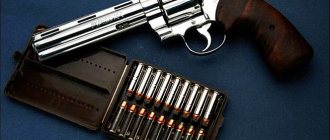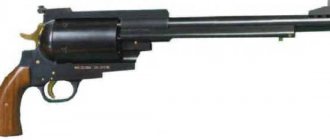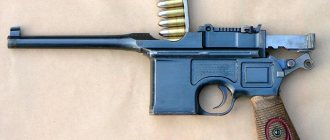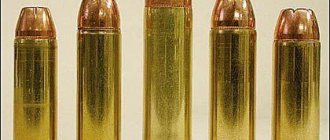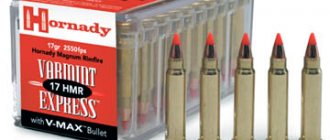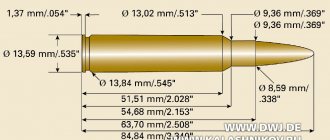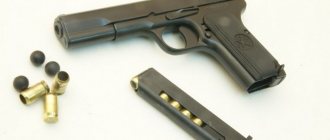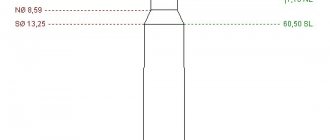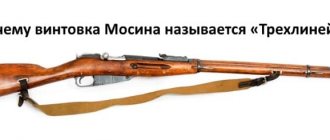Revolver cartridge developed by Elmer Keith and Philip B. Sharp
| .357 Magnum | |||
| .357 Magnum cartridges | |||
| Type | Pistol / Carbine | ||
| Place of origin | United States | ||
| Production history | |||
| Designer | Elmer Keith, Phillip B. Sharp | ||
| Developed | 1934 | ||
| Produced | 1935–present | ||
| Characteristics | |||
| Parent case | .38 Special | ||
| Type of shell | Edging ( R ), straight | ||
| Bullet diameter | 0.357 in (9.1 mm) | ||
| Neck diameter | 0.379 in (9.6 mm) | ||
| Base diameter | 0.379 in (9.6 mm) | ||
| Rim diameter | 0.440 in (11.2 mm) | ||
| Rim thickness | 0.060 in (1.5 mm) | ||
| Case length | 1.29 inches (33 mm) | ||
| Full Length | 1.59 inches (40 mm) | ||
| Case capacity | 26.2 g H 2 O (1.70 cm 3) | ||
| Primer type | Small magnum pistol | ||
| Maximum pressure | 35,000 psi Inch (240 MPa) | ||
| Maximum CUP | 45000 CUPS | ||
| Ballistic characteristics | |||
| 583 ft⋅lbf (790 J) | |||
| 158 g (10 g) JHP Federal | 1,240 ft/s (380 m/s) | 539 ft⋅lbf (731 J) | |
| 125g (8g) JHC Buffalo Bore* | 1,700 ft/s (520 m/s) | 802 ft⋅lbf (1087 J) | |
0.357 Smith & Wesson Magnum
The .357 S&W Magnum
,
.357 Magnum
or
9×33mmR
, as it is known in unofficial metric designation, is a smokeless powder cartridge with a bullet diameter of 0.357 inches (9.07 mm) . It was created by Elmer Keith, Phillip B. Sharp,[3] and Douglas B. Wesson[3][4] from firearms manufacturers Smith & Wesson and Winchester. [5] [6]
It is based on the earlier Smith & Wesson .38 Special cartridge. The .357 Magnum cartridge was introduced in 1934 and its use has become widespread since then. This cartridge ushered in the "magnum era" of handgun ammunition. [7] The .357 Magnum cartridge has high terminal ballistics.
Design[edit]
The Marlin Model 1894 C is a .357 Magnum carbine that complements revolvers. Two .357 Magnum cartridges, bottom and side views.
The .357 Magnum was jointly developed during the early to mid-1930s by a group of people in direct response to Colt's .38 Super Automatic. At the time, the .38 Super was the only American pistol cartridge capable of defeating the car cover and early ballistic vests that were just beginning to appear in the post-World War II "gangster era." [ citation needed
] Testing at the time showed that these vests destroyed any handgun bullet traveling at less than 1,000 feet per second (300 m/s). The Colt .38 Super Automatic barely exceeded this speed and was able to penetrate the doors and vests of cars that bootleggers and bandits used as cover. [8]
Although the .38 and .357 cartridges appear to be different diameters, they are actually identical, as 0.357 inches (9.07 mm) is the bullet diameter of the .38 Special cartridge. The special .38 nomenclature refers to the previous use of cartridge bullets (such as the .38 Short Colt and .38 Long Colt) that were the same diameter as the case. The only size difference between the .38 Special and the .357 magnum is the difference in case length; this was done to prevent accidental loading of the .357 magnum cartridge into the .38 Special revolver, which was not designed for the higher chamber pressures of the .357 magnum. Case volume was not a factor in increasing case length since the .38 Special was originally a black powder cartridge and the .357 magnum was designed using only the much denser smokeless powder.
Much of the credit for the early development of the .357 goes to hunter and experimenter Elmer Keith. Keith's early work in loading the .38 Special to higher pressure levels was made possible by the availability of heavy target-oriented revolvers such as the Smith & Wesson .38-44 "Heavy Duty" and "Outdoorsman" .38 .44 caliber revolvers. caliber. The .38-44 HV load used the .38-Special cartridge, loaded at a much higher velocity than standard .38-Special ammunition. The .38-44 revolvers were made using a .44 Special gun with a bored barrel for .357 caliber cartridges (the true diameter of a .38 Special bullet) and a bored cylinder for cartridges ranging from 0.3801 to 0.3809 in (9.65–9. 67 mm) (where the name "38 Special" originated). Because the frame, cylinder, and barrel were much stronger than standard .38 Special components, it was capable of withstanding much higher pressures. The .38-44 HV cartridge, which was no longer produced, was in most cases equal to the later .357 Magnum, which operates at more than twice the pressure of the standard .38 Special. The .357 Magnum addresses safety issues that previously had cartridges extending the cartridge by approximately 1/8 inch (3.2 mm), preventing the high-pressure .357 cartridge from entering a firearm chambered for the shorter, lower-pressure .38 Special. [9] Elmer Keith also introduced the Keith style bullet, which increased the mass of the bullet outside the case while leaving more room inside the case for gunpowder. The Keith bullet also used a large flat pad, allowing for rapid energy transfer for improved wound properties. At the same time, a bullet of this design does not deform like a hollow point, and, as a result, provides greater penetration. These characteristics of the Keith bullet make it very suitable for both hunting and target shooting.
To re-establish itself as a leading supplier of law enforcement weapons, Smith & Wesson developed the .357 Magnum, and Douglas B. Wesson (grandson of co-founder Daniel B. Wesson) [4] led the effort at Smith & Wesson along with significant technical assistance from Philip B. Sharp, Member of the Technical Division of the National Rifle Association. The new cartridge was developed from Smith & Wesson's existing .38 Special cartridge. This used a different powder load, and eventually the case was extended by 1/8" (3.2 mm). Extending the hull was more a matter of safety than necessity. Because the .38 Special and the early experimental .357 Magnum cartridges loaded by Keith were identical in physical characteristics, it was possible to load the experimental .357 Magnum cartridge into a .38 Special revolver with potentially disastrous results. Smith & Wesson's solution of slightly enlarging the case made it impossible to chamber a magnum round in a gun not designed to handle the extra pressure. [5] However, although both the .38 Special and .357 Magnum would be chambered in Colt's New Army revolvers in .38 Long Colt, due to the straight-walled chambers it created dangerous pressure levels up to three times that of the New Army. designed to withstand.
Bullet selection for the .357 Magnum cartridge changed during development. During development at Smith & Wesson, the original Keith bullet was slightly modified to be shaped like a Sharpe bullet, which itself was based on the Keith bullet, but which had 5/6 the bearing surface of a Keith bullet; Keith bullets are typically made oversized and understated. Winchester, however, after further experimentation during the development of the cartridge, slightly changed the shape of the Sharpe bullet, while retaining the outline of the Sharpe bullet. Thus, the final bullet choice was based on the earlier Keith and Sharp bullets, although with slight differences from both. [10]
AutoMag, attempt number two
A good name should not be wasted - apparently, Harry Sanford, already mentioned above, thought the same thing. In the late 1980s, he introduced a new line of AutoMag II, III, IV and V pistols, manufactured by AMT (Arcadia Machine and Tool) and IAI (Irwindale Arms Inc). What these pistols had in common with the above-mentioned original “AutoMag” was just the name - they were based on the design of the legendary Colt M1911, with differences in the design of the trigger mechanism, safety and barrel unlocking unit.
AutoMag III
We are most interested in model III, IV and V pistols chambered for .30 M1 carbine (7.62×33), .45 Win Mag and .50AE. They weighed approximately 1.3 kilos without cartridges, and in terms of ballistics they did not differ from the analogues listed above for the same calibers.
AutoMag IV
Dimensions [edit]
Maximum .357 Magnum CIP Cartridge Dimensions. All dimensions in millimeters (mm) [11]
The .357 Magnum cartridge has a 1.66 milliliter (25.6 grains H2O) case capacity.
Cartridge headspaces on the rim of the body. Typical rifling twist rate for this cartridge is 476 mm (1 in 18.74 inch), six grooves, bevel ø = 8.79 mm, slot ø = 9.02 mm, bevel width = 2.69 mm, primer type - small pistol magnum. [eleven]
According to CIP regulations, the .357 Magnum case can withstand up to 300.00 MPa (43,511 psi) maximum piezo pressure. In countries where CIP is regulated, each handgun cartridge combination must be tested to 130% of this maximum CIP pressure to be certified for sale to consumers. This means that weapons chambered for the .357 Magnum cartridge in CIP-regulated countries are currently (2018) proof tested at 390.00 MPa (56,565 psi) piezo pressure. [eleven]
Performance[edit]
| This section may contain original research . |
Introduced in 1935, the Smith & Wesson Model 27 was the first revolver chambered for the .357 Magnum cartridge.
.357 IMI Desert Eagle, one of the few semi-automatic pistols firing the .357 Magnum cartridge.
This cartridge is considered by many to be an excellent metallic silhouette hunting and self-defense round. [ citation needed
] When properly loaded, it can also be effective against large or dangerous game such as bear and ungulates;
[ citation needed
], however, many find larger, more powerful Magnum cartridges such as the .500 S&W Magnum, .460 S&W Magnum, .50 Action Express, .44 Magnum, .454 Casull, .41 Magnum, and 10mm Auto more suitable.
[ original research?
] By comparison, the .357 Magnum has lower energy than larger Magnum revolver cartridges, but has a smaller diameter and higher velocity, resulting in excellent penetration properties. This is an excellent round for small to medium game and is sufficient for deer hunting at reasonable ranges if a competent shooter uses the proper loads. For further comparison, the .357 Magnum has a higher velocity at 100 yards (91 m) than its parent case (.38 Special) at the muzzle. [12] The .357 Magnum's in-game performance is similar to that of the .45 Colt., but with a much flatter trajectory due to its higher velocity. It has been used with success for self-defense, plinking, hunting or target shooting. [13]
The original 357 load was a 158-grain bullet with a reported muzzle velocity of 1,510 fps. (Mutual velocity was measured using a revolver with a fairly long barrel.) Most modern loads are quite soft compared to the original loads.
Revolvers chambered for the .357 Magnum cartridge have the significant advantage that they can also load and fire the shorter, less powerful .38 Special cartridge. Compared to the .357 Magnum, the .38 Special also has lower cost, recoil, noise, and muzzle flash. The ability to shoot the .38 Special makes .357 revolvers ideal for new shooters who are not yet accustomed to shooting .357 magnum loads at full power but don't want to invest in a second, less powerful gun for practice. However, .38 specialty ammunition should not generally be used with a semi-automatic
a .357 Magnum pistol or rifle, as such firearms require the greater recoil produced by firing the .357 Magnum cartridge to cycle properly.
It also became popular as a "dual-use" cartridge, in short, lightweight rifles such as the American "Wild West" lever action. In the rifle, the bullet leaves the barrel at about 1,800 feet per second (550 m/s), [14] making it much more versatile than the .30 Carbine or .32-20 Winchester. In the 1930s it was found to be very effective against steel car doors and ballistic vests, and metal-piercing rounds were once popular in the United States among highway patrols and other police organizations. The .357 magnum revolver has been largely replaced by modern high-power semi-automatic pistols for police use, but it is still very popular as a backup weapon and among recreationists, security guards, and civilians for hunting, metallic, target shooting, and self-defense . The 9mm Winchester Magnum, which is also known as the 29mm 9×, was designed to duplicate the performance of the .357 Magnum in a semi-automatic pistol, [15] as did the .357 SIG cartridge.
Some common performance parameters are shown in the table below for several .357 Magnum cartridges. Bullets weighing between 110 and 200 grains (7.1 and 13.0 g) are common. Hollow case loads with 125 grain (8.1 g) jackets are popular for self-defense, while heavier loads are typically used for hunting. [ Citation required
] Loads ranging from approximately 400 to 800 ft-lb muzzle energy are available and can be selected for a variety of applications based on desired use and risk assessments.
| Manufacturer | Load | Weight | Speed | Energy | Extension | Penetration | PC [16] | TSC [16] |
| American | Quik-Shok JHP | 125 g (8.1 g) | 1,409 ft/s (429.5 m/s) | 551 ft⋅lbf (747.1 J) | fragment | 9.0 in (228.6 mm) | 2.7 USD inches (44.2 cm 3 ) | 47.5 c.u. (778.4 cm 3) |
| Atomic munitions | Hollow point match | 158 g (10.2 g) | 1,350 ft/s (411.5 m/s) | 640 ftlbf (867.7 J) | 0.71 in (18.0 mm) | 15 inches (381.0 mm) | X | X |
| Double tap | JHP Golden Point | 125 g (8.1 g) | 1,600 ft/s (487.7 m/s) | 711 ftlbf (964.0 J) | 0.69 in (17.5 mm) | 12.75 inches (323.8 mm) | 4.8 USD inches (78.7 cm 3 ) | 69.3 USD in (1135.6 cm 3 ) (estimate) |
| Federal | Classic JHP | 125 g (8.1 g) | 1,450 ft/s (442.0 m/s) | 584 ft⋅lbf (791.8 J) | 0.65 in (16.5 mm) | 12.0 in (304.8 mm) | 4.0 USD inches (65.5 cm 3 ) | 79.8 USD in (1307.7 cm 3) |
| Remington | JHP Golden Saber | 125 g (8.1 g) | 1,220 ft/s (371.9 m/s) | 413 ft lbf (560.0 J) | 0.60 in (15.2 mm) | 13.0 in (330.2 mm) | 3.7 USD inches (60.6 cm 3 ) | 30.4 USD in (498.2 cm 3) |
| Remington | Half year | 158 g (10.2 g) | 1,235 ft/s (376.4 m/s) | 535 ftlbf (725.4 J) | 0.36 in (9.1 mm) | 27.5 inches (698.5 mm) | 2.8 USD inches (45.9 cm 3 ) | 12.9 cu. Inches (211.4 cm 3 ) |
| Winchester | Silvertip JHP | 145 g (9.4 g) | 1,290 ft/s (393.2 m/s) | 536 ft⋅lbf (726.7 J) | 0.65 in (16.5 mm) | 14.3 inches (363.2 mm) | 4.7 USD inches (77.0 cm 3 ) | 33.7 USD inches (552.2 cm 3 ) |
Legend:
Expansion
- diameter of enlarged bullet (ballistic gelatin)
Penetration
- depth of penetration (ballistic gelatin)
PC
- constant cavity volume (ballistic gelatin, FBI method)
TSC
- temporary expansion cavity volume (ballistic gelatin)
NAACO Brigadier
One of the main lessons of history is that these same lessons, as a rule, teach no one anything. This is what happened immediately after World War II with the Canadian company NAACO.
She offered the Canadian Army the Brigadier pistol, which in appearance and design replicated the famous Browning High-Power of the 1935 model. The main difference between the Brigadier and the Browning pistol was its size, weight and ammunition. The .45 NAACO cartridge was loaded with a bullet weighing 14.9 grams, which had a muzzle velocity of 488 meters per second, with a muzzle energy of 1780 J - three times more than a nine-millimeter high-power Browning.” The weight of the pistol without cartridges was 1.9 kilos.
NAACO Brigadier
The Canadian Army refused to seriously test this monstrous model, and only a few images of it from old weapons manuals have reached us.
Comparison[edit]
Colt Pythons in 8" and 6" barrels
1956 Colt .357 Magnum
The .357 Magnum was a direct competitor to the .38 Super.
In terms of accuracy, the .357 Magnum has at least the same accuracy potential as the benchmark .38 Special wadcutter cartridge—indeed, a good .357 Magnum revolver will shoot .38 Special wadcutter cartridges with good results. It is this accuracy and power, as well as the versatility of using less expensive and softer .38 Special ammunition, that makes the .357 Magnum revolver an excellent weapon for many different disciplines, starting at 20 yards (18 m) accuracy. long range shooting with falling plates. This is a great round for anyone thinking about handloading ammo as it is economical and performs consistently.
The .357 Magnum was developed from the earlier .38 Special. This was possible because the .38 Special was originally designed to use black powder, which requires two to five times as much powder by volume to achieve the same velocity with the same bullet as the much more efficient smokeless powder. So the .38 Special has a relatively large case. The 9 × 19 mm Parabellum was introduced the same year (1902) but was originally developed for smokeless powder, and at higher pressures (235.00 MPa (34,084 psi) P max pressure piezo). [17] Thus, it produces significantly more energy than the .38, despite its case being less than half the size of the powder capacity. Many .38 Special cartridges use the same powders with the same charge weight, but because the case is so much larger, light targets with fast-burning powders may only fill the case 1/8 full. Filling the case with slow-burning powders produces much more power, but also much more pressure; too much pressure for older smaller frame revolvers chambered in .38 Special. It is to withstand these high power and high loads that the longer .357 Magnum was developed along with stronger revolvers designed to use it.
The .357 SIG was developed in 1994 and was named "357" to highlight its intended purpose: to duplicate the performance of 125-grain (8.1 g) .357 Magnum loads fired from 4-inch barrel (100 mm) revolvers, the cartridge intended for use in a semi-automatic pistol.
Wildey
The Wildey pistol, named after its creator Wildey Moore, appeared on the American market in 1980 - even slightly earlier than the famous Desert Eagle.
Over the next decades, the production of the pistol was stopped several times for financial reasons, and then resumed again. It is currently in production at USA Firearms Corp. Wildey Survivor
This large and heavy weapon has gas-operated automatic operation and a rotating bolt, which is quite rare for pistols. The main cartridge for Wildey is the .475 Wildey Magnum, developed specifically for him, which accelerates a 16-gram bullet to 560 m/s and 2600 J. Modern pistols are also offered chambered for the .44 AMP cartridge from the original AutoMag pistol.
It's worth noting that Wildy got his 15 minutes of screen fame by becoming the weapon of Charles Bronson, who starred in the third part of the original Death Wish films.
Links[edit]
Notes
- "Federal Cartridge Co. Ballistics Page" Archived September 27, 2007, at the Wayback Machine. federalcartridge.com.
- "Buffalo Bore Heavy 357 Magnum Pistol & Handgun Ammunition page" [ permanent dead link
] - ^ ab Sharp, Philip B. (1937). The Complete Guide to Loading and Unloading. Funk & Wagnalls. pp. 405 -406 - via Wayback Machine.
- ^ ab Wood, Keith (13 May 2015). "10 Things You Didn't Know About Smith & Wesson". americanhunter.org
. Retrieved September 20, 2022. Daniel Wesson's grandson, Colonel Douglas B. Wesson - ^ ab Dick Metcalf (February 2000). "Best Handgun Ammo of the 20th Century". Shooting time
. - Barnes, Frank S. (2006) [1965]. Skinner, Stan (ed.). Cartridges of the World
(11th ed.). Iola, WI: Gun Digest Books. p. 299. ISBN 0-89689-297-2. - Hawks, Chuck. "The .357 Magnum". Reboot information
. Weapons and shooting online. - Ayoub, Massad (March 2001). ".38 Super". Guns Magazine
. Archived from the original on September 9, 2004. Retrieved September 5, 2008. - ↑
Taylor, Chuck (May 2000).
".38-44 HV: The Original Magnum - Revolver Cartridge". Guns Magazine
. Archived from the original on December 27, 2007. - Sharp, Philip B. (1937). The Complete Guide to Loading and Unloading. Funk & Wagnalls. pp. 293 -294.
- ^ abc "TDCC .357 Magnum CIP Sheet" (PDF). C.I.P.
- Taylor, Jim. "Fifty-seven wine bottles in my life". Leverguns.com.
- "The Universal .357 Magnum" by Chuck Hawks (subscription required)
- .357 magnum results. Ballistics in inches
- Taffin, John. "Taffin 9mm Magnum Tests". sixgun.com
. John Taffin. Retrieved May 15, 2011. - ^ ab Marshall and Sanov, Street Stoppers, Appendix A, Paladin 2006 ISBN 0-87364-872-2
- "TDCC 9mm Luger CIP Sheet" (PDF). Archived from the original on April 7, 2014 (PDF). Retrieved April 5, 2014.
